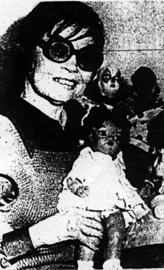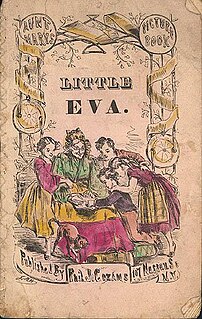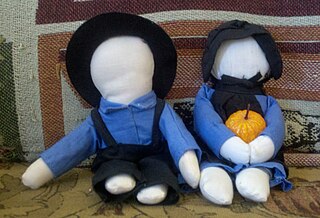
Uncle Tom's Cabin; or, Life Among the Lowly is an anti-slavery novel by American author Harriet Beecher Stowe. Published in 1852, the novel had a profound effect on attitudes toward African Americans and slavery in the U.S. and is said to have "helped lay the groundwork for the Civil War".

A doll is a model of a character, often used as a toy for children, and an artistic hobby for adults. Dolls have also been used in traditional religious rituals throughout the world. Traditional dolls made of materials such as clay and wood are found in the Americas, Asia, Africa and Europe. The earliest documented dolls go back to the ancient civilizations of Egypt, Greece, and Rome. They have been made as crude, rudimentary playthings as well as elaborate art. Modern doll manufacturing has its roots in Germany, from the 15th century. With industrialization and new materials such as porcelain and plastic, dolls were increasingly mass-produced. During the 20th century, dolls became increasingly popular as collectibles.

The Wind Done Gone (2001) is the first novel written by Alice Randall. It is a bestselling historical novel that tells an alternative account of the story in the American novel Gone with the Wind (1936) by Margaret Mitchell. While the story of Gone with the Wind focuses on the life of the daughter of a wealthy slave owner, Scarlett O'Hara, The Wind Done Gone tells the story of the life of one of her slaves, Cynara, during the same time period and events.

Aunt Jemima is a brand of pancake mix, syrup, and other breakfast foods. The Aunt Jemima pancake mix was advertised in 1889 as the first ready-mix. By 1915 it had become one of the most recognized brands in US history, and changed US trademark law.
Japanese dolls are one of the traditional Japanese crafts.
Pickaninny is a word applied originally by people of the West Indies to their babies and more widely referring to small children. It is a pidgin word form, derived from the Portuguese pequenino. Within Melanesian pidgin languages the word is utilised to describe a child without any connotation of a slur. Subsequently, the word is used in Canada and the U.S. as a racial slur referring to a dark-skinned child of African descent. In modern sensibility, the term can imply an archaic depiction or caricature used in a derogatory and racist sense.

A mammy, also spelled mammie, is a U.S. stereotype, especially in the South, for a black woman who worked in a white family and nursed the family's children. The mammy figure is rooted in the history of slavery in the United States. Black slave women were tasked with domestic and childcare work in white American slaveholding households.

Sula is a 1973 novel by Nobel Prize-winning author Toni Morrison, her second to be published after The Bluest Eye (1970).

Torchy the Battery Boy was the British second television series produced by AP Films and Gerry Anderson, running from 1959 to 1961. Directed by Anderson, it was a collaboration with author Roberta Leigh, with music scored by Barry Gray, art direction from Reg Hill and special effects by Derek Meddings.

Generalizations and stereotypes of African Americans and their culture have evolved within American society dating back to the colonial years of settlement. In the 2010s, African-Americans continued to be depicted with negative racial stereotypes in news reports and in fiction such as films and TV shows, despite common belief that modern society has in many ways progressed past racist views. These stereotypes are diversified, widespread and of long-standing, and are the primary focus of this article.

Kenneth Casey was an American composer, publisher, author, and child movie star in early silents.

Jackie Ormes is known as the first African-American woman cartoonist and creator of the Torchy Brown comic strip and the Patty-Jo 'n' Ginger panel.

A black doll is a doll of a black person. Representations, both stereotypical and realistic, fashioned into playthings, date back centuries. More accurate, mass-produced depictions are manufactured today as toys and adult collectibles.

Nancy Green was a storyteller, cook, activist, and the first of many African-American models hired to promote a corporate trademark as "Aunt Jemima". The famous Aunt Jemima recipe was not her recipe, but she became the advertising world's first living trademark.
"All the Pretty Little Horses" is a traditional lullaby from the United States. It has inspired dozens of recordings and adaptations, as well as the title of Cormac McCarthy's 1992 novel All the Pretty Horses.

Little Eva: The Flower of the South is an Anti-Tom children's book by American writer Philip J. Cozans. Although its publication date is unknown, scholars estimated the release was either in the 1850s or early 1860s. The book follows Little Eva, the daughter of a wealthy Alabama planter. She is characterized through her kindness toward slaves as she reads the Bible to them and teaches the alphabet to slave children. On her ninth birthday, Little Eva nearly drowns, but is rescued by a slave named Sam. Her parents free Sam who decides to remain with the family because he loves them.

Amish dolls are a type of rag doll and a popular form of American folk art, which originated as children's toys among the Old Order Amish people. While some Amish dolls have faces, the best-known ones do not, to emphasize the fact that all are alike in the eyes of God.
Sister Citizen: Shame, Stereotypes, and Black Women in America is a book published in 2011 through Yale University Press written by the American MSNBC television host, feminist, and professor of Politics and African American Studies at Tulane University, Melissa Harris-Perry. The book is an exploration of Black female identity in the US and the politics surrounding the perception of Black culture in America.















